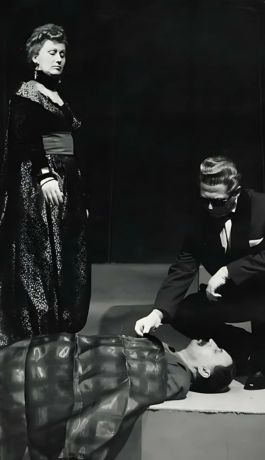Your cart is currently empty!

The Visit
A Masterpiece of Dark Justice
What price would you put on justice? In Friedrich Dürrenmatt’s darkly satirical masterpiece “The Visit” (Der Besuch der alten Dame), the answer is precisely one billion Swiss francs. When the world’s wealthiest woman returns to her impoverished hometown with an offer they can’t refuse, we witness how quickly moral principles can crumble in the face of economic necessity.
Quick Facts
- First performed: 1956 at Schauspielhaus Zürich, Switzerland
- Original title: Der Besuch der alten Dame
- Runtime: Approximately 140 minutes
- Structure: Three acts
- Notable adaptations: 1964 film starring Ingrid Bergman, Maurice Valency’s English adaptation, Kander and Ebb’s musical version “The Visit” (2015)
- Awards: New York Drama Critics’ Circle Award for Best Foreign Play (1958)
Just want to read the play?

Selected Writings Vol 1 – Joel Agee translation
In addition to The Visit, includes The Physicists, Romulus the Great, Hercules and the Augean Stables, and The Marriage of Mr. Mississippi.

Tony Kushner adaptation
This adaptation by Kushner was performed at the National Theatre in London in 2020, directed by Jeremy Herrin, and starring Lesley Manville and Hugo Weaving.
Free version? Try the version on Internet Archive: https://archive.org/details/visitdramainthre0000durr
Historical Context
Written in post-World War II Europe, “The Visit” emerged from a continent grappling with its recent moral failures. Switzerland’s neutrality during the war and its subsequent economic prosperity provided Dürrenmatt with the perfect backdrop to explore collective guilt and moral corruption. The play’s premiere coincided with the economic miracle of the 1950s, making its critique of materialism particularly pointed.
Plot Overview
Claire Zachanassian, now the world’s richest woman, returns to her hometown of Güllen, which has fallen into desperate poverty. She offers the town one billion Swiss francs, but with a condition: they must kill Alfred Ill, her former lover who abandoned her when she was young and pregnant, leading to her expulsion from the town. Initially, the townspeople reject this proposal with moral indignation. However, as time passes and new credit flows into the town, they gradually rationalize their way toward murder, all while maintaining their pretense of civilized behavior.
Themes & Analysis
Justice and Vengeance
Dürrenmatt masterfully blurs the line between justice and revenge. Claire’s methodical waiting game – she knows the townspeople will eventually succumb to temptation – demonstrates how justice can be bought when wrapped in the guise of moral righteousness. Her mechanical body parts (she’s survived several accidents) symbolize the mechanistic nature of her revenge.
Collective Guilt
The true power of “The Visit” lies in its examination of collective responsibility. While Alfred Ill committed the original sin against Claire, the entire town participated in her humiliation and expulsion. Their eventual decision to murder Ill becomes a representation of society’s complicity in evil acts.
Economic Morality
The gradual corruption of the townspeople through the promise of wealth serves as a scathing critique of capitalism. The yellow shoes that begin appearing on citizens’ feet become a brilliant symbol of their moral decay – a visible sign of their growing acceptance of murder as their purchases increase on credit.
Revolutionary Elements
Dürrenmatt’s use of “tragic comedy” revolutionized post-war theatre. He believed that tragedy in its classical sense was impossible in the modern world, as individual heroes had been replaced by bureaucratic systems. His use of grotesque elements – Claire’s prosthetic limbs, the townspeople’s gradual transformation into a mob while maintaining their civic pride – creates a uniquely unsettling theatrical experience.
Cultural Impact
“The Visit” has become a cornerstone of 20th-century theatre, particularly influential in the development of tragicomedy and absurdist theatre. Its exploration of collective guilt resonated strongly in post-war Europe and continues to find relevance in discussions of corporate responsibility and moral compromise.
Staging & Performance
The play presents unique challenges for directors. The gradual moral decay of the town must be shown subtly, while Claire’s grotesque entourage (including her eunuch servants and a black panther) creates a carnival-like atmosphere that contrasts with the town’s supposed civility. The most successful productions maintain a delicate balance between comedy and horror.
Reading Guide
Best Translations
- Maurice Valency’s English adaptation (most commonly performed)
- Joel Agee’s translation (most literal)
- Patrick Bowles’ version (best captures the dark humor)
Reading Tips
- Pay attention to the economic symbolism throughout
- Notice how the townspeople’s language changes to justify their actions
- Watch for recurring motifs: yellow shoes, the panther, mechanical parts
- Note the use of chorus-like elements in the townspeople’s collective voice
Contemporary Relevance
The play’s themes remain startlingly relevant today:
- Corporate influence on community decisions
- The rationalization of unethical behavior for economic gain
- Cancel culture and public shaming
- The power of wealth to influence justice
Fun Facts & Trivia
- Dürrenmatt wrote the role of Claire specifically for German actress Therese Giehse
- The play was inspired by the author’s visit to the small town of Gümligen
- The original production featured elaborate mechanical scenery that transformed the stage
- The name Güllen means “liquid manure” in German, adding to the play’s satirical edge
Conclusion
“The Visit” endures because it asks uncomfortable questions about human nature and moral compromise. Its brilliant combination of dark humor and moral inquiry creates a theatrical experience that’s both entertaining and deeply disturbing. In an era of increasing wealth inequality and moral relativity, its message resonates more strongly than ever.
Additional Resources
- “Understanding Friedrich Dürrenmatt” by Kenneth S. Whitton
- “Friedrich Dürrenmatt: Selected Writings” for context on his other works
- The 1964 film adaptation with Ingrid Bergman
- Documentary: “Portrait of a Planet: Friedrich Dürrenmatt”
Discussion Questions
- How does economic desperation justify moral compromise in the play?
- Is Claire Zachanassian a villain or a hero?
- What role does the community play in individual moral decisions?
- How does the play’s use of grotesque elements enhance its themes?
- What parallels can you draw between Güllen and modern communities?


Leave a Reply